We’ve all watched and read about the record low water levels for iconic western reservoirs like Lake Powell and Lake Mead on the Colorado River, but the ongoing drought isn’t unique to the American Southwest. From New Mexico to southwest Montana and west across the Rockies to the Sierra-Nevada of California, some of America’s most-storied trout waters are in real trouble.
Southern Colorado, home to rivers ranging from the Arkansas and the Gunnison to the Animas and the Rio Grande, is experiencing another year of mega-drought snowpack — as of this writing, the snow-to-water equivalent in these drainages — according to the Natural Resources Conservation Service — ranges from about 65 percent of normal in the Gunnison basin to only 16 percent of normal in the upper Rio Grande.
Heading north, things get a little better, but not much, according to NRCS data. In Wyoming, snow-to-water equivalent ranges from a low of 69 percent of normal in the lower Green River drainage to a high of 111 percent of normal in the Tongue River basin in the north-central region of the state. Iconic drainages like the Yellowstone and the Madison-Gallatin that get their genesis inside Yellowstone National Park sit at 94 and 79 percent of normal, respectively. The headwaters of the Snake River presently enjoy a snow-to-water ratio of 90 percent of normal.
In southwest Montana, home to fabled trout fisheries like the Yellowstone, the Madison and the Beaverhead, the snow-to-water equivalent sits between 90-95 percent of normal. The northern quarter of the state looks much better, with percentages well above 100 percent of normal.
In neighboring Idaho, the pattern continues. The northern tier of the state, including the panhandle region, is enjoying the fruits of a solid winter, with snow-to-water equivalents ranging from a low of 105 percent of normal in the far north of 182 percent of normal in the Weiser River basin on the state’s western border with Oregon.
But the state’s famous trout fisheries in rivers like the Henry’s Fork, the South Fork and the Teton are all pushing through a second straight drought year. Remember, too, that these rivers aren’t just trout rivers — they are sources of much of southern Idaho’s irrigation water for crops ranging from wheat and barley to sugar beets and potatoes. Residents living in Idaho’s southern half are being told that reservoirs won’t be filled this summer and that it will be a short and likely costly irrigation season for the agricultural community, with snow-to-water equivalents ranging from 81 percent of normal in the Henry’s Fork basin to only 72 percent of normal in the Owyhee basin in the state’s southwest corner.
West to California, things look especially bleak along the spine of the Sierra, where most of the NRCS measurement stations register less than 50 percent of normal when it comes to water contained within the remaining snowpack.
For anglers, this is another year of bad news in a string of bad-news years. If there’s any good news, it’s coming in a cold, wet spring that’s likely not doing much to boost existing snowpack, but is contributing to a delayed runoff that will certainly help big-water trout when temperatures do finally reach their summer peaks. But it’s safe to assume that anglers in the West — or those traveling west to fish this summer — will see more seasonal fishing closures, “hoot owl” angling restrictions and likely the negative impacts of a multi-year drought on some of the best trout rivers in the country.
So what do we do?
Well, not to be doom-and-gloom, but if you want to fish big water for for big trout, come early before it gets too hot and dry, or plan on spending your fishing vacations on tailwaters like the Roaring Fork and the Taylor in Colorado, or on the South Fork of the Snake or the South Fork of the Boise in Idaho. The Paradise Valley reaches of the Yellowstone in Montana, where anglers are now frequently reporting catches of smallmouth bass, will almost certainly see seasonal closures as summer pushes spring aside, and other notable rivers, like the Big Hole and the Truckee will almost certainly be impacted by low water and hot summer days.
Another option: plan to fish smaller water higher up in the drainages of your favorite trout water. Even in drought-stricken Colorado, high-elevation trout water should be fishable (and it should be fishable early) all summer long. The same holds true for most western drainages — the small streams that flow from the high country on U.S. Forest Service lands will be more hospitable to trout as summer gets going.
No, the fish aren’t as big, but they’re plentiful and opportunistic. If you know where to go in some of these western retreats, you can catch surprisingly big fish in small water — but don’t expect locals to offer up too many tips. It’s been an exhausting few years of drought and heat in trout country, and while summer tourists do fire up the economy, trout fishing hotspots are closely guarded these days.
You have more choices, of course. With gasoline prices well above $4 a gallon across most of the West, a road trip to Yellowstone or Rocky Mountain National Park will cost twice as much this summer. If you have trout water close to home, by all means, stretch your budget and hit an Appalachian tailwater instead of following through with plans to hit the Madison in July.
Sadly, judging from the data that just keeps getting more and more depressing, this may be the “new normal” in the West — we’re getting less snow and summer seems to start earlier every year. And our trout are struggling. Last summer, by mid-July, iconic trout rivers like Montana’s Bitterroot experienced fish-kills as water temperatures climbed in the low- to mid-70 — for trout, the ideal water temperatures for active feeding range between 45 and 60 degrees. Once the water gets warmer than that, trout become sluggish. Above 65 degrees, an encounter with an angler could prove deadly, even if the fish is released.
If you must fish in the west this summer, consider these tips to help you — and the trout you’re after — get the most out of your experience:
Get a thermometer
You can get a water-temperature thermometer from your local fly shop. Attach it to your vest or sling pack and use it. Most of us who fish for trout often enough think we can tell when the water is approaching unsafe levels, but it never hurts to know for sure. If the water measures above 65 degrees, consider doing something else that day.
Keep fish wet
When water temperatures are warmer than you or the trout might like, it’s important to handle fish carefully. If possible, don’t lift them from the water at all, and try to avoid hand-on-scale contact at all. This stresses fish and reduces or removes their slime coating. When you add this in with warmer-than-preferred water temperatures, it often translates into death for stressed trout.
Fish early and fish late
Fish early in the morning after a good eight or so hours of darkness and that patented Rocky Mountain chill combine to cool the waters or nearby trout streams. When days climb into the 80s, it’s probably time to take a break. If you must, fish again after the sun has dipped a bit, and the ambient air temperatures are dropping, too.
Fish smaller, higher waters
The Rockies and the West are full of high-country trout streams that might require a bit more effort to reach, but can be rewarding when it comes to fishing. Because, even in the heat of summer, daytime temperatures remain mild, trout water is fishable, usually throughout the entirety of the season. Generally, the fish you catch will be on the smaller side. But … it beats not fishing at all.
Consider other species
It’s time for trout anglers to branch out a bit, and experience other species, particularly in the heat of summer. Bass and panfish offer great angling opportunities all summer long, and less-heralded fish, like carp and bullhead offer some of the best freshwater sport most anglers will ever experience. For coastal anglers, striped bass, redfish, spotted trout and sheepshead all offer fly rodders excellent sport through the summer months. Sure, it’s hotter and muggier, but the fishing can be stellar.
A warming climate isn’t doing trout any favors. Some scientific predictions, based on current climate-change models, say the United States will lose half of its trout over the next 40 to 60 years, simply because their habitat is becoming less hospitable. It’s a daunting notion — for many of us, our grandchildren might represent the last generation of trout anglers in America.
But, for today’s trout anglers, making some adjustments in how and when we fish is likely what will keep trout around for the foreseeable future. A few small sacrifices can go a long way toward protecting our beloved fish … and our fishing.




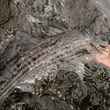
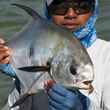

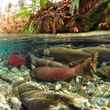



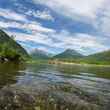
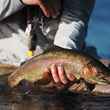



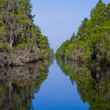
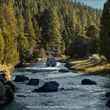



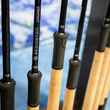
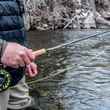






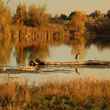
Comments
Jock Conyngham replied on Permalink
Chris, great article on an important topic—and thank you—but here are a couple of points:
—Your advice to fish in morning or evening (“if you must”) during hot periods is, as you indicate with that qualifying phrase, a little uneven. Water temps take hours to drop after peak air temps. If people want to go back out about 1 AM, that would likely be about right. Check the temperature data at USGS gages to get a sense of this. Afternoons and evenings are a good time to drink beer, tie flies, and prepare to fish early the next day.
—Hoot owl restrictions are a compromise with outfitters and guides. If you care about quality trout fishing and conservation it’s best to watch water temps, not the clock.
—A brown trout can’t even maintain its body weight when water hits 67 degrees; it’s already deeply stressed. Consider a far more conservative standard for your own fishing. More and more anglers around the West are quitting when water temperatures exceed 62F.
—If a guide encourages you to fish trib mouths, springs, and similar thermal refugia where fish congregate by the hundreds during hot periods, get yourself a new guide. Those fish are making a last ditch stand for survival. Don’t buy the excuse of “watch; the fish will swim away fine on the release”. Most mortalities occur much later than the release—even 24 hours later—due to acidosis and lactic acid processes.
—When discussing snow water equivalence measures, anglers should be aware that NRCS uses a shifting thirty year dataset to calculate averages and medians. In December 2021 data from the 1980’s were excised from the active dataset. The median snow water equivalent for the period that included the decade of the ‘80’s was significantly higher than that of the current reference period for many basins—so be aware that it literally is a new normal. Snowpack equivalents now have to be well over 100% in those basins just to meet the previous median. NRCS advises caution in comparing periods, explaining that data collection and analytic methods have changed, but also explains that long-term trends are minimized because of the shifting time window.
These are tough years for coldwater fisheries in the West. Your article goes a long way toward showing anglers who love the resource how to act on that. Again, thanks to Chris and Hatch.
Pages